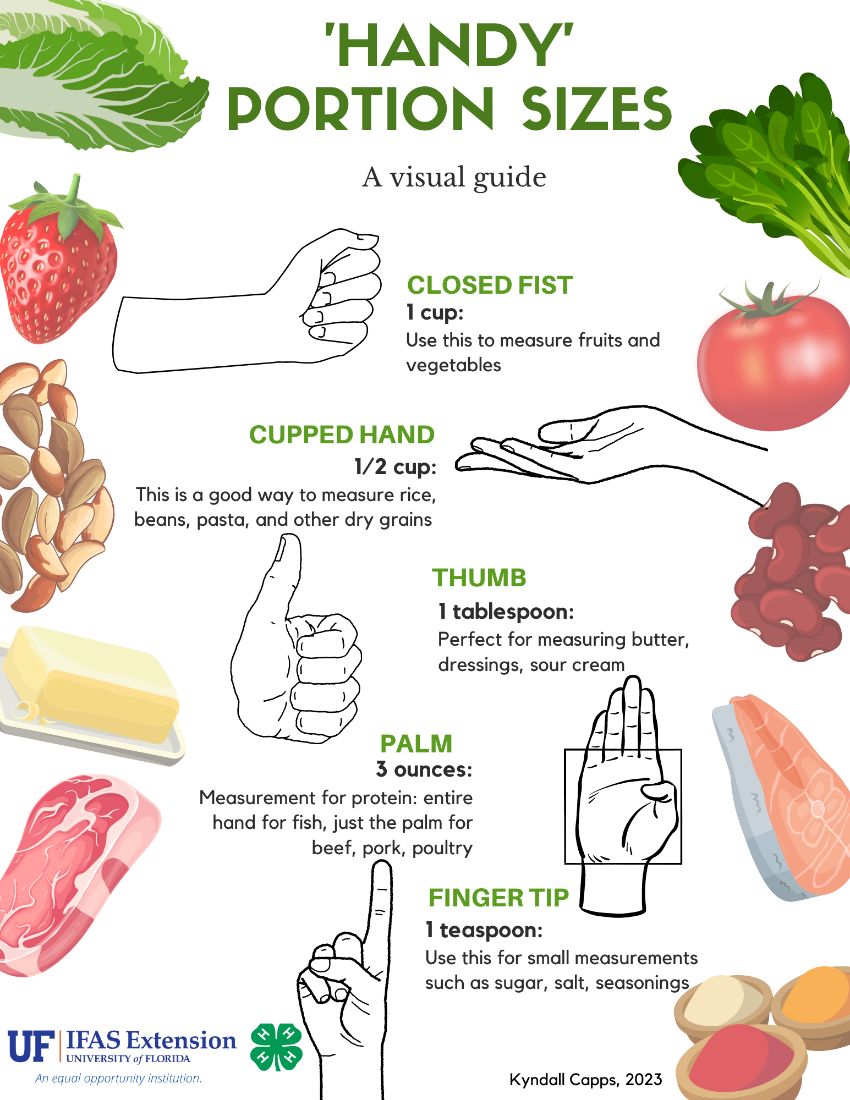Portion sizes and overall calorie intake in the United States have significantly increased over the last 50 years. Americans are consuming approximately 374 more calories per day than in 1970, going from an average of 2,016 to 2,390 total calories per day. Along with this increase in calories, portion sizes have grown larger over the years. Research has shown that people tend to eat more of a food when they are given a bigger portion. Larger portions provide more calories, and those extra calories can lead to weight-related problems such as high blood pressure, high cholesterol, type 2 diabetes, heart disease, sleep apnea, low quality of life, mental illness, and body pain. Understanding portion control can help you eat the right amount of food to maintain a healthy weight.
What is portion control?
Portion control is understanding how much food your body needs and being able to limit yourself to that amount. An important thing to consider along with portion control is energy balance, which means making sure you balance the calories you eat with physical activity. Portion control is less difficult than it sounds. Read on to learn how to control your portions and make sure you are getting the right amount of food.
What is portion distortion, and how does it affect me?
Portion distortion is a term used to describe how portion sizes have grown over the last few decades. Because we are eating larger portions of food, we now see these larger portions as normal. This trend is seen in all kinds of foods in America: hamburgers are 25% larger; a plate of Mexican food has increased in size by 33%; soft drinks are 52% larger; and a typical bag of chips is 60% larger. Taking time to learn about portion control will make it easier for you to determine if a portion is too large, too small, or just right for your needs and will put you on the right track to controlling your portion sizes.
What are the recommendations?
The USDA has developed tools to help you identify how much food you should eat from each food group every day. You can determine recommended daily amounts of food based on your sex, height, weight, and activity level by visiting the MyPlate website at http://www.myplate.gov.
Having an idea of how much food you need in a day can help you make better choices about your portion sizes. The website also provides general guidelines for an "average" adult's daily food intake (Table 1).
Table 1. *Recommended daily amounts for adults.
What is the difference between serving size and portion size?
The serving size that we find as part of the nutrition facts label on packaged foods serves as a guide which helps define the nutritional value of that specific standardized amount of food or drink. It is not a recommendation of how much of that food to consume. Portion size is the amount you choose to eat at one time, which may consist of more than one serving.
How can I control my portion sizes?
When dining out:
Choose a healthy snack in advance, such as fruits, veggies, or unsalted nuts. Doing so will help keep you from overeating when dining out.
Start your meal with a small tossed salad, which has fiber and will help fill you up.
Place half of your meal in a to-go container right away to enjoy for another meal.
Order an appetizer instead of an entrée. Better yet, order one entrée and share it with someone else. You might find that you are full and satisfied at the end of the meal without being overstuffed.
Review the menu before heading out to identify healthier options.
When at home:
Be sure to use a bowl or a plate instead of snacking straight from the package. Avoid eating with distractions such as television and other activities going on at home.
Slow down your eating and put your utensils down between bites. It takes about 15 minutes for your brain to get the message that you are full.
Use smaller bowls and plates to avoid taking too much at one time.
Portion out leftovers for meals the following day or freeze into single portions to have meals ready to go.
Visualize your portion size. It can be difficult to "eyeball" the food on your plate and know exactly how many servings it is. An easy way to do this is to use your hand to estimate portion size. Use the infographic below to guide your servings.
Visualize your portion size
Listed below is a guide so you can use your hand to visualize portion sizes. A more comprehensive list of the amounts of specific foods that count as cups and ounces is available at https://www.myplate.gov/.

Credit: UF/IFAS
Summary
Portion control is a practical way of eating which helps you to maintain a healthy weight by ensuring you are getting the right amount of nutrients from the foods you eat. Consuming just 300 calories extra per day can lead to a weight gain of about 30 pounds per year. Gaining excess weight increases your risk of weight-related diseases. Taking steps to control your portions is a step towards healthy eating habits and improved overall health.
References
Bentley, J. (2017). U.S. Trends in Food Availability and a Dietary Assessment of Loss-Adjusted Food Availability, 1970–2014. USDA ERS. Retrieved from https://www.ers.usda.gov/publications/pub-details/?pubid=82219
CDC. (2022). Health Effects of Overweight and Obesity. Retrieved from https://www.cdc.gov/healthyweight/effects/index.html#:~:text=High%20blood%20pressure%20(hypertension).,Coronary%20heart%20disease
NIH. (2021). Food Portions: Choosing Just Enough for You. Retrieved from https://www.niddk.nih.gov/health-information/weight-management/just-enough-food-portions
USDA MyPlate. (n.d.). MyPlate. Retrieved from https://www.myplate.gov/